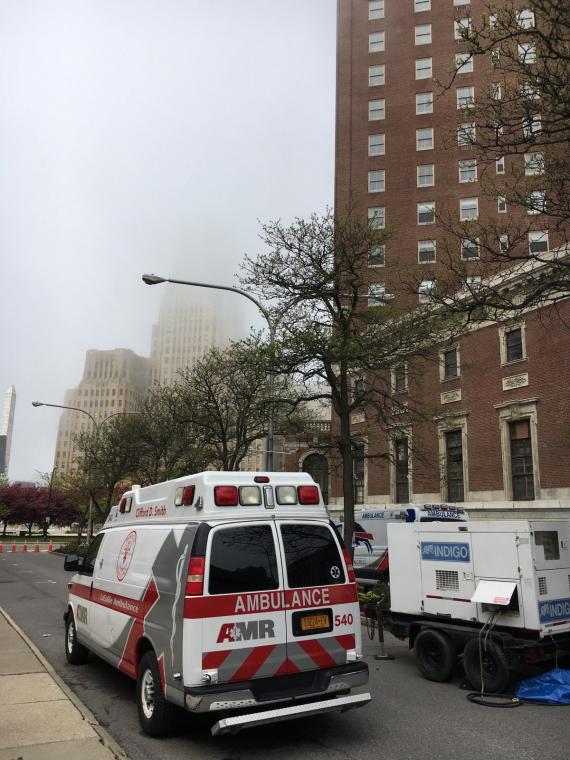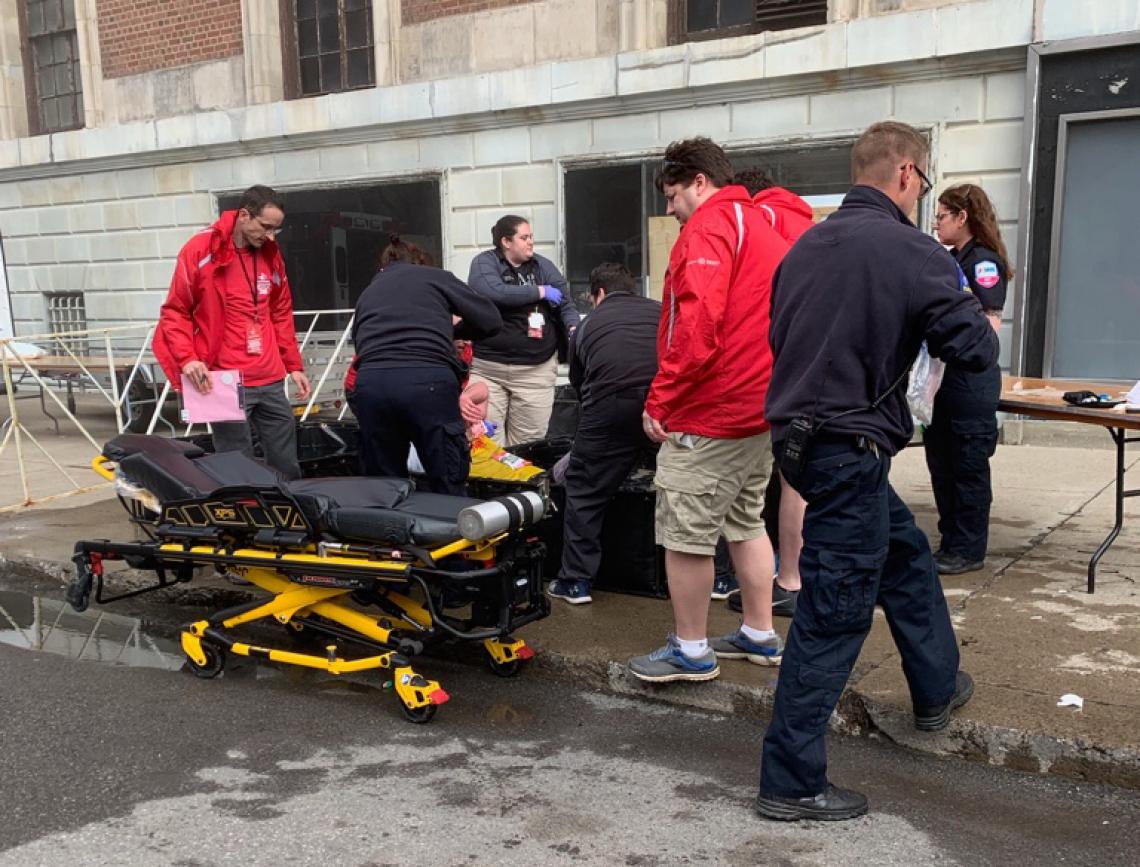
As temperatures around the country continue to reach record-breaking highs, the concern of heat-related illnesses remains at the forefront. However, as medical volunteers at this year’s Buffalo Marathon learned, under the right circumstances, exertional heat illness can be an issue in any weather condition.
For the second year, the athletic training faculty at the University at Buffalo volunteered during the annual Buffalo Marathon, which takes place at the end of May, a notoriously fickle time of year for the city in upstate New York.
“In Buffalo, during the last weekend in May, it might snow; it might be 80 degrees with 80 percent humidity,” said J. Luke Pryor, PhD, ATC, CSCS, clinical assistant professor at the University at Buffalo. “You can have two different weather extremes, which makes it somewhat challenging for runners to prepare for.”
While the 2018 race took place on a particularly hot day, the 2019 race was much different.
“During race day, it was 58 degrees, plus or minus 5 degrees, at the finish line,” Pryor said, adding that since the finish line was in downtown Buffalo, which is right next to Lake Erie, the humidity was approximately 89 percent. “What made the race so unique was that the entire downtown area was shrouded in fog for the entire race. That’s how humid it was. But, for a portion of the race, when you got away from downtown, there was no fog and the humidity was much lower, but the temperature was much higher.”

Prior to the start of the race, the medical volunteers – which consisted of physicians, sports medicine physician fellows, emergency medicine residents, EMTs, athletic trainers and athletic training students – met to discuss everyone’s skills and areas of expertise. They also discussed emergency action plans and Pryor gave a short presentation on exertional heat illness, including what to look for and how to treat.
“I said, ‘Look, we’ll probably not see very many heat-related issues today, except in athletes who are in the top quarter of finishers – those athletes who are going at a very high intensity.’ That’s because they’re generating so much metabolic heat, and in this really humid environment, they’re not losing that heat through sweat evaporation,” Pryor said. “We really didn’t see anyone with heat illness in the top 10 percent of finishers – most likely because they’re extremely fit and probably had some degree of heat acclimatization. Then, the bottom 80 percent, we didn’t see any issues. So it was really that middle 15 to 20 percent that we were worried about.”
About an hour and a half into the marathon, Ryan Krzyzanowicz, DAT, ATC, athletic training program director for the University at Buffalo, was notified that a runner had collapsed about 100 feet from the finish line. He, athletic training student Tyler Farnell and a paramedic went into the racecourse to treat the runner.
“He was semi-conscious,” Krzyzanowicz said. “I tried to talk to him, but he really wasn’t responding. … Automatically, I knew there was central nervous system dysfunction and noticed some heat stroke symptoms.”
The trio brought the runner to the medical tent where Pryor and Farnell took over care with the help of an EMT and physician.
“I’ve been doing this type of volunteer work for seven or eight years, and I’ve never had a scenario play out like this one did,” Pryor said. “It was unique on so many levels.
“I saw Ryan and [Tyler] go into the racecourse. There had been a report of a collapsed runner. At that point, with only that information, it can be just about anything. … As I saw them sprinting across the finish line with this runner in a wheelchair, I noticed he was unconscious, he was very pale, he was still sweating profusely. I looked over [to the person next to me] and said, ‘This is going to be very interesting. Let’s go.’”
As the interprofessional team began an initial assessment, Pryor quickly became concerned about exertional heat stroke.
“When you see enough of these, things slow down and you realize there are only a few things that could cause him to collapse, and one of those is exertional heat stroke,” he said. “We needed to rule that out right away given how deadly it could potentially become and how important it is to identify core body temperature and conduct cold water immersion.”
While the EMT and physician were evaluating vital signs and his responsiveness, Pryor informed the group of the need to obtain his core body temperature.
“As soon as I said that, Tyler just jumped to it,” Pryor said. “It was funny because we had [an exertional heat illness] lab just a few weeks earlier, so he was able to do it just boom, boom, boom.”
Farnell inserted the rectal thermometer as the EMT and physician continued with their assessments. Pryor said they watched as the temperature quickly climbed from 102.7 to 103.6 degrees.
“It hit 104.1, and I said, ‘OK, he’s classified as exertional heat stroke at this point in time, so we need to initiate cooling,’” Pryor said.
With the help of a couple other athletic training students, they moved the runner into one of the HAZMAT decontamination pools donated by the Buffalo Fire Department to be used as cold water immersion tubs. They began adding as much ice as possible to the tub already filled with water.
“One of the things I was really impressed about our group of volunteers was that by the time we had him submerged, the EMT already had an intravenous line in, they already had heart-rate and blood pressure monitoring, we had someone taking notes,” Pryor said. “You couldn’t have asked for better medical care.”

Pryor continued to monitor the runner’s temperature. He said he expected it to increase slightly within the first few minutes of cooling; however, to his surprise, the runner’s temperature reached 110.1 degrees.
“[Prior to this,] 108.1 degrees was the highest body temperature I had ever treated,” Pryor said. “This was the highest, or second-highest, recorded body temperature of an exertional heat stroke patient that I or anyone at that site had ever seen.”
The team continued treatment, including vigorously stirring the water, while the runner remained unconscious. He finally regained consciousness when his temperature reached 106 degrees.
“We kept asking him questions, and he was fairly lucid, which was kind of surprising,” said Pryor, adding that he believes the saline and anti-nausea medication the runner received from the EMT and physician helped in his recovery.
After 20 minutes of cooling, the team decided to remove the runner from the cooling tub, even though his body temperature was 103.9 degrees.
“What’s important is that we took him out in an environment that was roughly 58 degrees, which is comparatively cold, especially with the high humidity,” Pryor said. “So his temperature continued to drop.”
The team continued to monitor the runner’s vital signs. When his body temperature reached 98 degrees, they thought he would start to stabilize – but he didn’t.
“This is the other remarkable point of this case: We had to start re-warming him,” Pryor said. “It could have been a number of things, but we figured it was probably that the cool environment wasn’t assisting his ability to regulate his body temperature.
“At that point, we decided to send him by ambulance to the hospital to ensure proper body temperature regulation and evaluate of his other biological systems to ensure there was nothing else that was wrong as a result of the exertional heat stroke.”
Thanks to the quick action of the marathon’s volunteer medical staff, the runner has reportedly made a full recovery.
“It was better than being at a hospital,” Pryor said. “I had asked the [volunteer] physicians what they would have done if he arrived at the emergency room [in that state], and they went through other cooling modalities that I knew from a research perspective weren’t as efficient as cold water immersion. … It literally was the best care in the world [he could have received] at that moment.”
Pryor and Krzyzanowicz said the team’s preparedness positively impacted their ability to properly and quickly treat the runner. Starting the day with a medical timeout helped foster interprofessional collaboration. It also shined a light on the unique skillset athletic trainers have, especially in regards to exertional heat stroke.
“EMTs and physicians have never really seen cold water immersion,” said Krzyzanowicz, adding that while they are familiar with heat stroke, they often don’t encounter exertional heat stroke. “They didn’t know their role. We made sure to do a medical timeout before the start of the marathon so each leader talked about their skillset and what they can do.
“It worked out really well. Everyone knew their role thanks to that medical timeout, and there wasn’t anyone arguing about the order in which to do things. Everyone was able to do what they needed to do to successfully treat the patient.”
When discussing the incident with their athletic training students after, Pryor and Krzyzanowicz emphasized how quick action and proper knowledge help save lives.
“I told the students, ‘Being able to save a life is scary,’” Pryor said. “But when properly trained, we possess the knowledge, skills and abilities to save lives.
“If you’re prepared and you’re well-informed of best practices, then when you do recognize that situation, it’s not a scary situation. It’s not a situation that you’re panicking or second-guessing yourself. … You’ve got steps that you follow and that really simplifies things. The event starts to slow down.”
This unique case of exertional heat stroke has brought about several questions the athletic training team at the University at Buffalo would like answered, such as is it the peak body temperature that influences body temperature regulation or is it the time above a certain body temperature that influences the body’s ability to regulate temperature?
“This spurred a lot of good ideas for future research, which we’re actually beginning to prepare some studies and investigate,” Pryor said. “There’s a lot to learn from this case. Only handful of studies have reported exertional heat stroke in cooler temperatures. This shows that, yes, it can happen in 58 degrees.”





